

Cheers To Finger Power! Future technology. Mind you, this is not a “Green” concept and neither does it claim to be “Eco Friendly”.
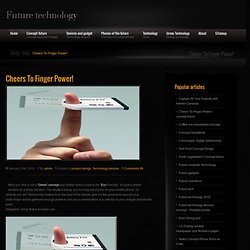
It’s just a helpful solution for a tricky situation. The situation being: you running out of juice on your mobile phone. So what do you do? Remove the battery from the back of the phone; give it a few good turns around your index finger and its gathered enough power to last you a conversation or a safe trip to your charger and electric point. Designers: Song Teaho & Hyejin Lee Future technology devices conceptEbook readersConcept phone nokiaInteresting technologyFuture computers conceptCool gadgets 2010Technology future. Amazing Rust.com - Bismuth Crystals.
How to make Bismuth crystals Bismuth Crystals Bismuth (element #83 on the periodic table) forms beautifully colored and geometrically intricate hopper crystals, shown in the image to the left, as it slowly cools and solidifies from its molten state.
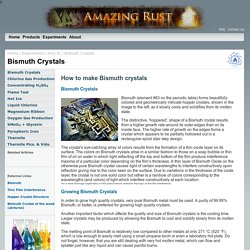
The distinctive, 'hoppered', shape of a Bismuth crystal results from a higher growth rate around its outer edges than on its inside face. The higher rate of growth on the edges forms a crystal which appears to be partially hollowed out in a rectangular-spiral stair step design. The crystal's eye-catching array of colors results from the formation of a thin oxide layer on its surface. Growing Bismuth Crystals. Touching a Boo-Boo Really Does Make It Feel Better. Clutching an injury does make it feel better, according to a study published in Current Biology, reducing the pain on average 64 percent.

But only if the injured party is the one doing the clutching (insert your own self-touching joke here). It doesn’t work if someone else does it. Study coauthor Marjolein Kammers explained to the Daily Mail what this means: “Pain isn’t just the signals coming from the body to the brain, but it is also the way the brain processes those signals,” she said. To test this, the Kammers and her team used a classical pain test called the thermal grill illusion, which causes pain without injuring someone. The researchers dunked each subjects’ two hands in to water of different temperatures (no, they did not wet the bed) to cause the sensation. After the painful stimulus a researcher either held the subject’s hands, let the subject press their hands together, or only let the subject touch one or two of their fingers together.
Image: Flickr/Racchio.
13 more things that don't make sense. Cookies on the New Scientist website close Our website uses cookies, which are small text files that are widely used in order to make websites work more effectively.
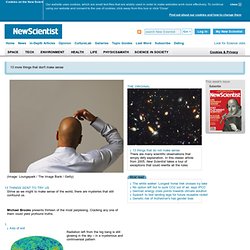
To continue using our website and consent to the use of cookies, click away from this box or click 'Close' Find out about our cookies and how to change them Log in Your login is case sensitive I have forgotten my password close. Anders Main Page. Potassium Chlorate and Gummy Bear. Thinking like an octopus. Stephanie Mitchell/Harvard Staff Photographer Peter Godfrey-Smith has been intrigued by octopuses for years, diving in and around Sydney Harbour during summer breaks in his native Australia.

Stunned by the lack of scientific research on octopuses, Godfrey-Smith is now studying their intelligence, and whether their tentacles have minds of their own. If you were an octopus, would you view the world from eight different points of view? Nine? The answer may depend on how many brains an octopus has, or, to say it another way, whether the robust bunches of neurons in its coiling, writhing, incredibly handy arms bestow on each of them something akin to a brain. The idea of a distributed mind among animals is not new, according to Peter Godfrey-Smith, who focuses his efforts on the philosophy of science. Bees Solve Complex Problems Faster Than Supercomputers. In a new study, researchers report that bumblebees were able to figure out the most efficient routes among several computer-controlled "flowers," quickly solving a complex problem that even stumps supercomputers.
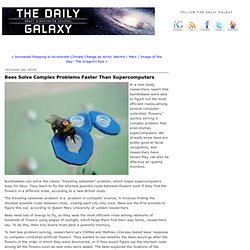
We already know bees are pretty good at facial recognition, and researchers have shown they can also be effective air-quality monitors. Bumblebees can solve the classic "traveling salesman" problem, which keeps supercomputers busy for days. They learn to fly the shortest possible route between flowers even if they find the flowers in a different order, according to a new British study. The traveling salesman problem is a problem in computer science; it involves finding the shortest possible route between cities, visiting each city only once.
Bees are the first animals to figure this out, according to Queen Mary University of London researchers. Stuff for Smart Masses. TFOT - The Future Of Things. Forensic Science Experts. Center for Brain Science. Etymology of Neuroscience Terms. Water Supply Solutions CU researchers propose rewilding. Carl Buell for Cornell University/Nature Could this be the Great Plains in 100 years?
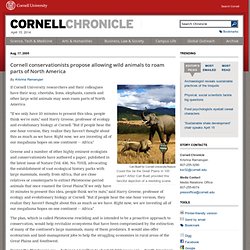
Artist Carl Buell provided this fanciful depiction of a rewilding scene. If Cornell University researchers and their colleagues have their way, cheetahs, lions, elephants, camels and other large wild animals may soon roam parts of North America. "If we only have 10 minutes to present this idea, people think we're nuts," said Harry Greene, professor of ecology and evolutionary biology at Cornell. "But if people hear the one-hour version, they realize they haven't thought about this as much as we have.
Science Saved My Soul.